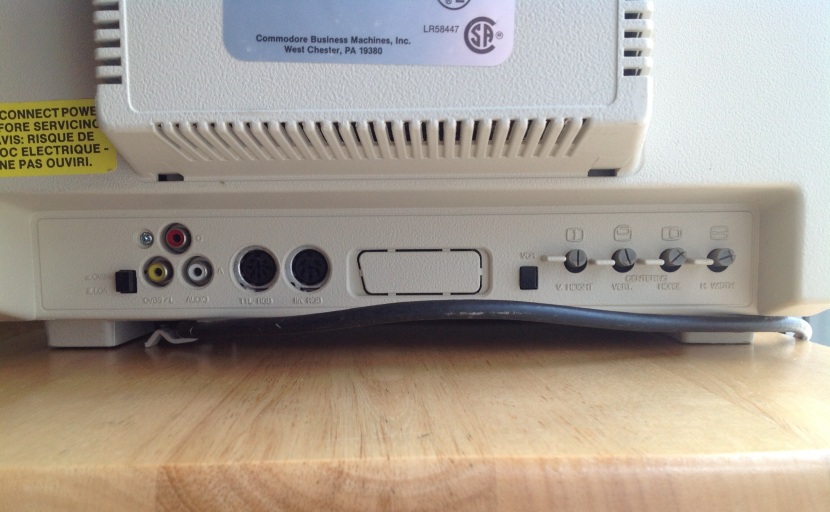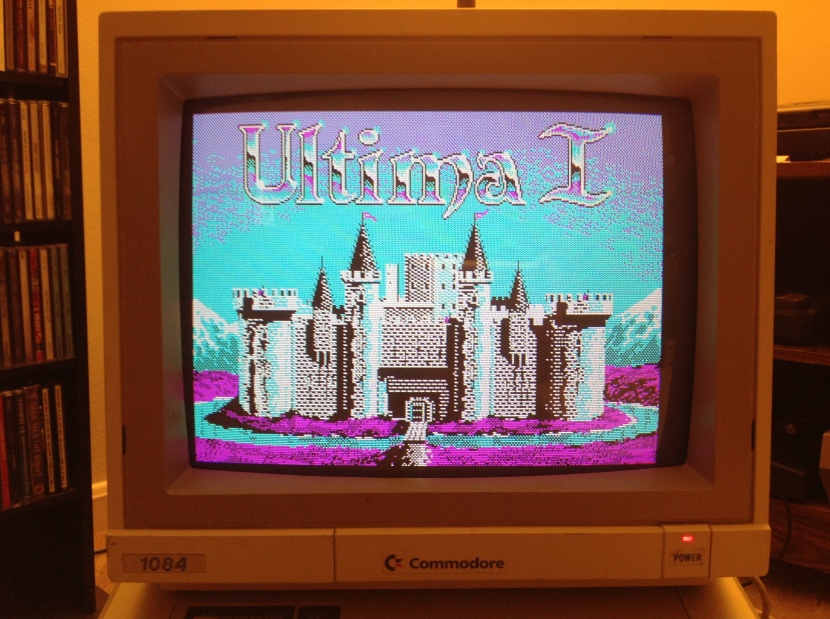Commodore 1084 Monitor
This is my Commodore 1084 monitor, which I believe was made sometime around 1987.
About two years ago an aunt and uncle that live nearby heard that I was looking for old computers and offered me my uncle’s first computer. When we got it out of their basement I found that he was giving me a Mitsuba-badged XT clone, as well as the monitor that had remained attached to it for over 20 years.
I was kind of shocked to find out the monitor was a Commodore! That was not a name I expected to see on a monitor connected to a PC.
The Commodore 1084 is an unassuming looking thing. I have to admit when my uncle first pulled it out of his basement, I was a little disappointed. I was hoping to see something really cool like an IBM 5130 Personal Computer Color Display Monitor. The Commodore 1084, on the other hand looks like any one of a myriad of generic composite monitors you may have seen in the 1980s or come upon in a school that kept it’s Apple IIs well into the 1990s.
Oh how wrong I was to be disappointed about the 1084. From what I gather this is actually a legendary monitor among Commodore aficionados. It looks remarkably generic looking until you look at the connections on the back.
What makes the Commodore 1084 legendary? Let’s take a closer look at those video connections on the left.
At first glance that looks like a standard cluster of a yellow composite video RCA input and two white and red RCA audio inputs next to two strange and proprietary DIN connectors.
But that’s wrong. The little switch to the left that’s labeled CVBS and LCA clues you into the real story.
Several of Commodore’s products such as the Commodore 64 supported a video signal that used two RCA connectors for Luminance (aka Luma) and Chroma. This is electrically identical to S-Video, which uses a more familiar small DIN connector. LCA stands for Luma, Chroma, and Audio. When the little switch is in the up position the yellow plug is for Luma and the Red plug is for Chroma.
The 1084 has an amplifier and a generous speaker built into it’s left side so the white connector is a standard mono audio input.
When the switch is in the down position the yellow becomes a standard composite video input and the white input is used for mono audio.
So, just in that cluster of three RCA plugs we can see that the monitor supports two major video standards of the time: composite and S-Video. That’s already much more interesting than one of those generic composite monitors.
So what’s TTL RGB? That’s what my uncle had his PC plugged into, via an adapter cable that went from the DB-9 CGA connector to the DIN connector on the 1084.
Yes, this monitor supports CGA (and by extension, some EGA modes). That’s interesting because unlike the analog VGA we’re all very familiar with, CGA basically sent very primitive digital signals to a monitor where, for example, the Red channel was either ON or OFF (rather than a varying intensity) depending on the color that was being sent. There have to be guts inside of the monitor to turn the TTL signals into video.
The second DIN connector is apparently for Linear RGB, which was an analog RGB standard supported on the Amiga, though, I don’t have an Amiga available to test that.
One of the controls on the front panel switches between the RGB DIN inputs at the RCA composite/S-Video inputs.
If you want to use composite, the front switch must be in CVBS and the rear switch must be in CVBS. If you want to use S-Video, the front switch stays in CVBS and the rear switch is set to LCA. If you want to use the TTL RGB for CGA, the front switch just needs to be in RGB. That seems a bit kludgy but you get used to it.
So, what is fascinating to me is that this unassuming monitor supports at least four of the major video standards of the time (and maybe more because I see some discussion that there was an adapter make the Apple IIgs work with the 1084). This makes sense because in this time period Commodore was selling Commodore 64s, Amigas, and PC clones and it was sensible for them to have a single monitor that worked with all of their products.
I’ve been spending a lot of time researching Apple products of the 1980s and this sort of blows my mind. At the same time as Commodore was selling the 1084 Apple had several video standards going for the Macintosh, Apple IIgs, and Apple IIe/Apple IIc and did not sell a single monitor that worked across their whole product line.
Now, to be fair, this is not a multisync monitor. All of these video standards that the 1084 supports have a common scan frequency. So, for example all of the standard this monitor support have a 15.75 KHz horizontal scan frequency and could never support the Macintosh II’s 35 KHz horizontal scan frequency.
Just to see for myself how well this monitor supports different standards, I cobbled together a little demonstration with some of the computers I have laying around. Keep in mind that taking photos of CRT monitors is a bit of a crapshoot.
First, an Apple IIe on the composite input.
Here are some scenes from the Apple IIe’s famous “Apple Presents…Apple” demo and tutorial disk. The Apple II’s color composite support was always a bit of a hack, and that’s why you’re seeing the odd green color fringing on the otherwise white onscreen keyboard. But, the orange carrots look fine.
The memorable scrolling Apple logo looks nice and colorful. That banding is an artifact from taking the picture.
Here is a Commodore 64 on LCA/S-Video.
First, the famous Commodore 64 “64K RAM System” boot screen.
That classic blue has never been bluer.
This title screen from Alien Syndrome looks fantastic and the accompanying audio that blares out of the 1084’s mono speaker is the bee’s knees.
The GEOS demo disk looks beautiful as well.
The kind of detail that you get from a Commodore 64 on S-Video just blows away the Apple IIe.
Finally, CGA. Now, I have to say that CGA is an abomination and one of the worst things that ever happened to the PC. CGA and it’s awful color pallet set back PC gaming for years. But to prove it can be done, here is the Ultima I title screen in all of it’s purple and teal CGA glory.
Confusingly, I’m using the Apple IIe as a stand here for the 1084. The PC is actually a Panasonic Senior Partner “luggable” 8088-based PC clone (that will undoubtedly be featured in a future post).
Here’s what Ultima I gameplay looks like in CGA….Yuck, but not the monitor’s fault.
Finally, I didn’t realize the 1084 had a plastic fold-down kickstand until I watched a YouTube video by vwestlife where he demonstrated the kickstand on his 1084.
After compiling this demonstration, I’m very impressed. It may not be as pleasant looking as one of Apple’s Snow White-era monitors but the Commodore 1084 is a computer collector’s dream in terms of versatility.
















You liked this monitor less at first glance than that fugly ibm one you linked to? What is wrong with you..?
Hi, i have also a c1084 din to rgb cable and wonder if you can connect a C64 to a vga screen wit this cable?
Nice article. Just grabbed one from ebay for my retro scanline goodness 🙂
What amuses me is that the case has what looks like a knockout, shaped just like a SCART connector.
My guess is the European version of this monitor had a SCART connector and was thus even more versatile than the North American version! I doubt it would have supported both 50 and 60Hz timings, though. That would have been too much. 🙂
Yes, the Euro version of the 1084 has the SCART connector on the back, and the DIN analog RGB connector is not populated with the hole blanked off. The monitor spec is 50Hz, but it can run 60Hz modes as well. I know because I have a 1084. It was the 2nd monitor to come after the 1081, and the guts is mostly the same except with added LCA mode. I actually own 15 Commodore monitors, mostly 108x, but also a 1802. The best and most versatile Commodore monitor of that era is the 1084S-P1, it has even more connectors on the back than the 1084 and 2 speakers inside too!
The 1084 is quite a monitor to have for a classic computer collector indeed.
Regarding the inclusion of TTL-RGB, this goes back to before Commodore started selling PCs, as the Commodore 128 uses this for its 80 column display. Analog rgb was indeed aimed at the Amiga, but the monitor also works very well for connecting to VCRs, dvd players and video tuners,
As to the PAL version having a scart connector, maybe such a variation was sold, but the rather European PAL 1084 I have here has the same connector layout as the one in this article, and does not have a scart connector.
An interesting detail about Commodore’s LCA ‘standard’ and s-video is that LCA predates s-video, but indeed is the same thing.